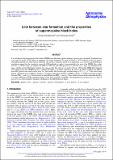Por favor, use este identificador para citar o enlazar a este item:
http://hdl.handle.net/10261/350418COMPARTIR / EXPORTAR:
 SHARE SHARE
 CORE
BASE CORE
BASE
|
|
| Visualizar otros formatos: MARC | Dublin Core | RDF | ORE | MODS | METS | DIDL | DATACITE | |

| Título: | Link between star formation and the properties of supermassive black holes |
Autor: | Mountrichas, George CSIC ORCID; Buat, Véronique | Palabras clave: | Galaxies: active Galaxies: evolution Galaxies: star formation X-rays: galaxies X-rays: general |
Fecha de publicación: | 2023 | Editor: | EDP Sciences | Citación: | Astronomy and Astrophysics 679: A151 (2023) | Resumen: | It is well known that supermassive black holes (SMBHs) and their host galaxies undergo a process of co-evolution. Feedback from active galactic nuclei (AGNs) plays an important role in this symbiosis. To study the effect of AGN feedback on the host galaxy, one popular method is to study the star formation rate (SFR) as a function of the X-ray luminosity (LX). However, hydrodynamical simulations suggest that the cumulative impact of AGN feedback on a galaxy is encapsulated in the mass of the SMBH, MBH, rather than the LX. In this study, we compare the SFRs of AGN and non-AGN galaxies as a function of LX, MBH, the Eddington ratio (nEdd), and the specific black hole accretion rate (λsBHAR). For that purpose, we used 122 X-ray AGN in the XMM-XXL field and 3371 galaxies from the VIPERS survey to calculate the SFRnorm parameter, defined as the ratio of the SFR of AGN to the SFR of non-AGN galaxies with similar stellar mass, M*, and redshift. Our datasets span a redshift range of 0.5 ≤ z ≤ 1.2. The results show that the correlation between SFRnorm and MBH is stronger compared to that between SFRnorm and LX. A weaker correlation is found between SFRnorm and λsBHAR. No correlation is detected between SFRnorm and nEdd. These results corroborate the notion that the MBH is a more robust tracer of the cumulative impact of the AGN feedback, compared to the instantaneous accretion rate (LX). Thus, it may serve as a better predictive parameter of changes in the SFR of the host galaxy. | Versión del editor: | https://doi.org/10.1051/0004-6361/202347392 | URI: | http://hdl.handle.net/10261/350418 | DOI: | 10.1051/0004-6361/202347392 | E-ISSN: | 1432-0746 |
| Aparece en las colecciones: | (IFCA) Artículos |
Ficheros en este ítem:
| Fichero | Descripción | Tamaño | Formato | |
|---|---|---|---|---|
| linkholes.pdf | 564,62 kB | Adobe PDF |  Visualizar/Abrir |
CORE Recommender
SCOPUSTM
Citations
3
checked on 18-may-2024
Page view(s)
20
checked on 22-may-2024
Download(s)
2
checked on 22-may-2024
Google ScholarTM
Check
Altmetric
Altmetric
Este item está licenciado bajo una Licencia Creative Commons

